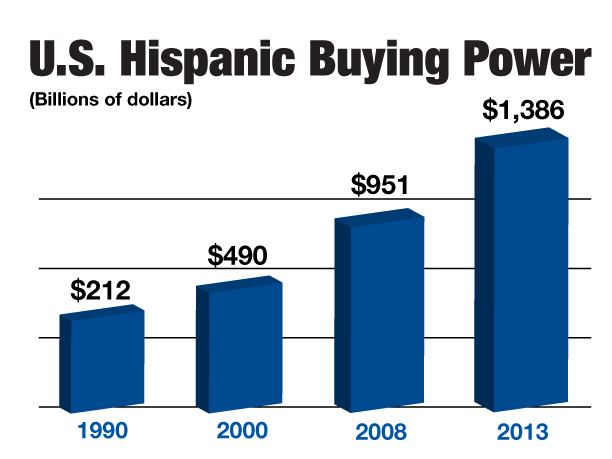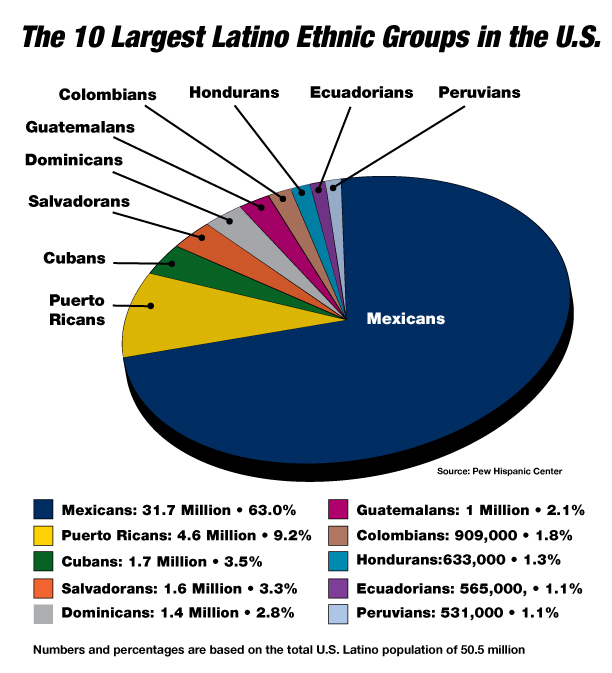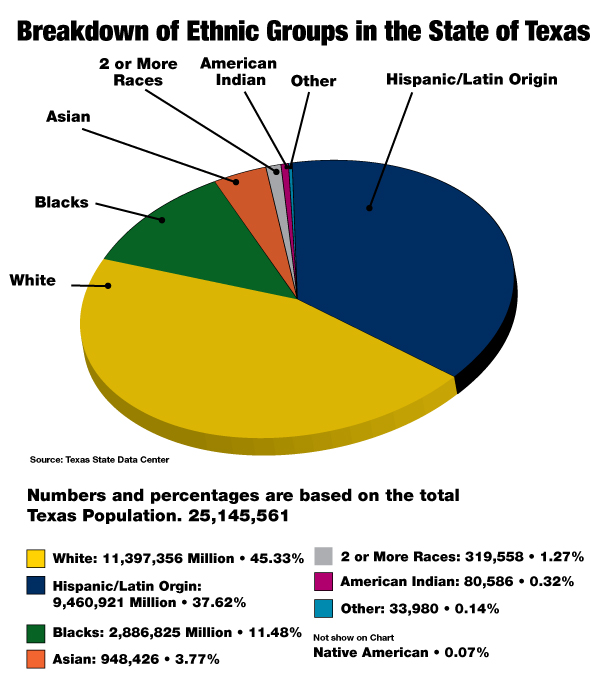Hispanic Facts & Stats (via USHCC and TAMACC)
The U.S. Hispanic population is now 50.5 million and is projected to double over the next 35 to 40 years. Hispanic buying power will exceed $1.3 trillion in 2013 and Hispanics continue to be brand loyal even during tough economic times
1
The United States is undergoing a demographic shift that is changing the face of this country. According to the 2010 census the U.S. Hispanic population surged 43%, rising to 50.5 million in 2010 from 35.3 million in 2000. Latinos now constitute 16% of the nation’s total population of 308.7 million.
The Census Bureau has also estimated that the non-Hispanic white population would drop to 50.8% of the total population by 2040 – then drop to 46.3% by 2050. This demographic transformation holds the potential to shift economic and political dynamics across the country.
Today one out of six people in the United States are Hispanic. However, it is important to note that one in four people under the age of 18 are Hispanic.
 The total number of people under age 18 rose by nearly two million over the decade. But the number of white children fell, while the number of Hispanic children rose sharply. During the decade, Texas alone added 979,000 individuals under age 18, of which 931,000 were Hispanic.
The total number of people under age 18 rose by nearly two million over the decade. But the number of white children fell, while the number of Hispanic children rose sharply. During the decade, Texas alone added 979,000 individuals under age 18, of which 931,000 were Hispanic.
Texas’ population grew to more than 25 million, awarding the nation’s second most populous state four more seats in the U.S. House of Representatives . Hispanics accounted for 65% of the state’s growth since 2000, while non-Hispanic whites experienced the smallest increase of any group, just 4.2%. The black population grew by 22%.
The Latino population overall grew faster than expected and accounted for more than half of the nation’s growth over the past decade, with the group’s increase driven by births and immigration. The Hispanic market certainly deserves greater attention than many businesses and corporations give it.
The total Hispanic buying power in this country is growing rapidly. It grew from $212 billion in 1990 to $951 billion in 2008, to a projected $1.4 trillion by 2014. A 600% increase in just twenty-four years.
The demographic shift that is changing the face of this country is far from complete. The U.S. Hispanic population is expected to double to 100 million by 2050. By then it is estimated that one in four people in this country will be Hispanic.
10 Facts that the Recent Census Data Shows About Hispanics in Texas
 2010 Census data puts Texas’ population at 25.1 million people, of which 9.4 million are Hispanics, or 37.6% of the total state population. It is the state with the 2nd largest Hispanic population (behind California) but is equal to California in terms of share of population.
2010 Census data puts Texas’ population at 25.1 million people, of which 9.4 million are Hispanics, or 37.6% of the total state population. It is the state with the 2nd largest Hispanic population (behind California) but is equal to California in terms of share of population.
POPULATION GROWTH
- Hispanics accounted for 65% of the population growth in the state in the last decade
- With 9.4 million Hispanics, Texas accounts for 18.7% of the total Hispanic population in the United States
- 48% of all Texans under 18 are Hispanic, many are second generation
LOCATION
- 4 of the top 10 cities with the highest number of Hispanics are in Texas (Houston, San Antonio, El Paso & Dallas), accounting for 3.7 million Hispanics
- 4 of the top 10 cities with the highest percentage of Hispanics as part of their total population are in Texas (Laredo: 95.6%, Brownsville:93.2%, McAllen:84.7% and El Paso:80.7%)
- Hispanics are the majority population in 51 counties in Texas
- 17 counties doubled their population since 2000, most growth in metropolitan areas, specifically Dallas, Houston and Austin.
- Counties with the largest Hispanic populations: 1.7 million in Harris County, 1 million in Bexar County and .9 million in Dallas County
IDENTIFICATION
- The country of origin of most Hispanics in Texas is Mexico, with 7.95 million. The second most sizable population is Salvadorian (.22 million).
ECONOMIC CLOUT
- According to data from Selig Center, Hispanic consumer spending in Texas was $176 billion (20% of the Hispanic national total) or $18,500 per capita
With the data above, the implications of the demographic trends cannot be ignored. The marketing opportunities available to companies in Texas that want to begin exposing Hispanics to their brand here, could have big payoff, with a young population growing into their peak earning and spending years in the near future.
3
New Data on the Hispanic Population in U.S. States and Counties
Nearly half of the Nation’s Hispanic Population Lives in California or Texas
Nation’s Hispanic Population Grew in Nearly Every County Between 2000 and 2010

Among the key findings from the state profiles:
- The 10 states with the largest Hispanic populations are California, Texas, Florida, New York, Illinois, Arizona, New Jersey, Colorado, New Mexico and Georgia.
- The 10 states in which the Hispanic share of the population is highest are New Mexico, Texas, California, Arizona, Nevada, Florida, Colorado, New Jersey, New York and Illinois.
- Nearly half (47%) of all Hispanics live in California (14.1 million) or Texas (9.5 million), down from 50% in 2000.
- California has 5.4 million Hispanic immigrants, more than any other state. California is followed by Texas, with 2.9 million Hispanics immigrants, and Florida with 2.1 million Hispanic immigrants.
- Slightly more than half of Hispanics in Maryland (54%), the District of Columbia (52%) and Alabama (51%) are foreign born, the highest foreign born shares among Hispanics in the U.S.
Among the key findings from the county database:
- Los Angeles County, California, has the nation’s largest Hispanic population—-nearly 4.7 million.
- More than 95% of the populations in the Texas counties of Webb, Starr and Maverick are Hispanic—-the highest Hispanic population shares in the nation.
- The Hispanic population is more dispersed today than in 2000. Then, the 50 counties with the largest Hispanic populations had two-thirds (64%) of the nation’s Hispanic population. In 2010, those same counties contained 59% of all Hispanics.
- Only four counties had a decrease of more than 1,000 people in their Hispanic population between 2000 and 2010—-New York County, NY; Arlington County, VA; Rio Arriba County, NM; and Duval County, TX.
4
Hispanics are more likely to respond to advertising
 Data by a Terra/ComScore study shows that Hispanics are:
Data by a Terra/ComScore study shows that Hispanics are:
- 37% more responsive to targeted ads (vs 30% of non-Hispanics)
- 37% of Hispanics vs 25% of non-Hispanics enjoy the interactivity of online video ads and the ability of obtaining more information than the information provided in TV ads
- 36% of Hispanics vs. 24% non-Hispanics claim that Internet advertising has motivated them to visit a retail establishment
Google’s data confirms this.
- 61% of Hispanics made a purchase in-store as a result of seeing online advertisements while researching products (20% more than the general population)
- When Hispanics view videos while shopping, 66% consider product reviews and ratings.
- 41% of Hispanics watching video leads to a purchase online & 33% made a purchase in-store
Other data released by ComScore shows that Hispanics are more likely to remember advertised products while shopping (35% vs 22% of non-Hispanics) and that advertising actually helped them choose products to buy (30% vs 15%). Other influences include customer reviews, expert ratings and reviews on blogs.


